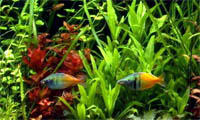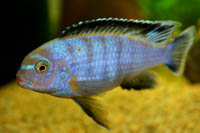

The Greater Seattle Aquarium Society’s Conservation Award Program (CAP) encourages aquarists to take part in the conservation of aquatic creatures. From the popular pea pufferfish (Carinotetraodon travancoricus, vulnerable) and spotted nerite snail (Neritina natalensis, near threatened) to the rarely seen golden skiffia (Skiffia francesae, extinct in the wild) and soda cichlid (Alcolapia alcalicus, endangered), even a single five gallon aquarium can help keep our endangered species from going extinct both in the hobby and in the wild.
Endangered species come in all shapes, sizes, and care requirements, so even the newest hobbyist can take part. Unfortunately, all new animals are regularly becoming imperilled in their native habitats, so whether you already have a species or are considering acquiring a new one make sure to check their status on the IUCN’s red-list regularly to see if the species you keep apply.
For questions about the GSAS CAP, or to locate an at-risk species please contact your CAP Support Team through e-mail or at one of our monthly meetings.
The purpose of the Conservation Award Program is to ensure the continuing survival of imperiled species in the aquarium hobby through the continued captive breeding and sharing of the species in our care.
The Conservation Award Program has several major objectives:


Participation is easy. Just go to submission portal here and fill out the form. A photograph of the species in your care is required for submission - you can upload a photo of the species into the form for submission. The photo should be a clear, focused close-up shot and is for identification purposes.
CAP species qualification can be determined one of two ways:
CAP also provides a great Species Journal which allows you to record and keep detailed information about the species in your care. This Species Journal is completely optional and does not have to be submitted for acceptance into CAP. This is a holdover from the days when GSAS was a CARES program branch, so is a CARES document.
pointsystem, similar to BAP:
| Activity | Points | Repeatable? | Annual Max Points | Points earned per species | Notes |
|---|---|---|---|---|---|
| Keeping CAP species | 5 | No | 5 | Yes | Members are encouraged to 1) keep CAP species and 2) keep them for an indefinite period of time. |
| Yearly breeding of CAP species | 10 (15 EW) | Once yearly | 10 (15 EW) | Yes | Given the conservation status of a CAP species, successful breeding of a CAP species should be rewarded. (fry must survive longer than 30 days) |
| Sharing CAP species with GSAS members or GSAS auction donation | 5 for spawn group | Yes | 15 | Yes | Keeping true to the CAP spirit, sharing with other members and/or donating to GSAS auctions is highly encouraged. A minimum or one male/female pair is required, but larger groups are encouraged. Maximum of 15 points per year, per species. |
| CAP species knowledge sharing (either GSAS live meeting presentation, or GSAS Newsletter article contribution) | 10 | Yes | No max | N/A | Members are encouraged to share knowledge about CAP species through research or personal experience. CAP articles or presentations are not limited to species the member is in possession of, and can also cover a larger subject to species/habitat conservation. |
| Tier | Notes |
|---|---|
| Roe Tier | 25 minimum points, have a species in the program |
| Embryo Tier | 50 minimum points, keep a listed species (not data-deficient, not non-listed) |
| Wiggler Tier | 100 minimum points, breed at least one species in care |
| Fry Tier | 200 minimum points, sell or share a group of six of a species at a meeting |
| Juvie Tier | 400 minimum points, keep an extinct in the wild species |
| Spawner Tier | 600 minimum points, submit an article to the newsletter on a listed species (not data-deficient) |